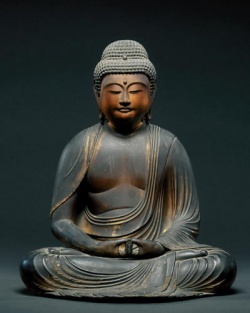Difference between revisions of "Lha Totori Nyentsen"
| Line 1: | Line 1: | ||
[[File:Amida_Nyorai.jpg|thumb|250px|]] | [[File:Amida_Nyorai.jpg|thumb|250px|]] | ||
| − | [[Lha Totori Nyentsen]] ([[lha tho tho ri gnyan btsan]]; Central [[Tibet’s]] earliest exposure to [[Buddhism]] is ascribed to the reign of the twenty-eighth [[king]] [[Lha Totori Nyentsen]] ([[lha tho tho ri gnyan btsan]]; 374-493), although there may have been even earlier contacts in the Sino-Tibetan borderlands. However, the formal introduction of the [[Buddhist teachings]] coincided with the nine great | + | [[Lha Totori Nyentsen]] ([[lha tho tho ri gnyan btsan]]; Central [[Tibet’s]] earliest exposure to [[Buddhism]] is ascribed to the reign of the twenty-eighth [[king]] [[Lha Totori Nyentsen]] ([[lha tho tho ri gnyan btsan]]; 374-493), although there may have been even earlier contacts in the Sino-Tibetan borderlands. However, the formal introduction of the [[Buddhist teachings]] coincided with the [[nine great religious kings]] who forged an [[empire]] in {{Wiki|Central Asia}} between 629 and 848. Legend has it that the first [[Buddhist]] [[sutra]] introduced to [[Tibet]] was in the [[Yumbu Lakang]]. During the reign of [[Lha Totori Nyentsen]], the [[28th Tibetan king]], a [[book]] and some other [[religious]] [[objects]] fell on the roof of the [[Yumbu Lakang]] one day. No one knew what they were so that they kept them in the [[monastery]]. |
Many years later, the [[book]] was found out to be a [[Buddhist]] [[sutra]]. "Central [[Tibet’s]] earliest exposure to [[Buddhism]] is ascribed to the reign of the twenty-eighth [[king]] [[Lha Totori Nyentsen]] ([[lha tho tho ri gnyan btsan]]; 374-493), although there may have been even earlier contacts in the Sino-Tibetan borderlands. "[[Yumbu Lakang]] is the oldest-known dwelling in [[Tibet]], its construction surrounded by various [[myths]] and {{Wiki|legends}} associated with the founding of the [[Tibetan]] {{Wiki|civilization}}. One such [[myth]] tells that [[King]] [[Nyatri Tsenpo]] descended from [[heaven]] in the 2nd century BCE to build the castle. Another legend claims that the [[28th King of Tibet]], [[Lha Totori Nyentsen]], resided here late in the 4th century… the [[Dharma]] first descended on [[Tibet]] from the sky during the legendary [[Tibetan Emperor]] [[Lha Totori Nyentsen]]. | Many years later, the [[book]] was found out to be a [[Buddhist]] [[sutra]]. "Central [[Tibet’s]] earliest exposure to [[Buddhism]] is ascribed to the reign of the twenty-eighth [[king]] [[Lha Totori Nyentsen]] ([[lha tho tho ri gnyan btsan]]; 374-493), although there may have been even earlier contacts in the Sino-Tibetan borderlands. "[[Yumbu Lakang]] is the oldest-known dwelling in [[Tibet]], its construction surrounded by various [[myths]] and {{Wiki|legends}} associated with the founding of the [[Tibetan]] {{Wiki|civilization}}. One such [[myth]] tells that [[King]] [[Nyatri Tsenpo]] descended from [[heaven]] in the 2nd century BCE to build the castle. Another legend claims that the [[28th King of Tibet]], [[Lha Totori Nyentsen]], resided here late in the 4th century… the [[Dharma]] first descended on [[Tibet]] from the sky during the legendary [[Tibetan Emperor]] [[Lha Totori Nyentsen]]. | ||
{{E}} | {{E}} | ||
[[Category:Tibetan Buddhist History]] | [[Category:Tibetan Buddhist History]] | ||
Latest revision as of 19:50, 14 April 2014
Lha Totori Nyentsen (lha tho tho ri gnyan btsan; Central Tibet’s earliest exposure to Buddhism is ascribed to the reign of the twenty-eighth king Lha Totori Nyentsen (lha tho tho ri gnyan btsan; 374-493), although there may have been even earlier contacts in the Sino-Tibetan borderlands. However, the formal introduction of the Buddhist teachings coincided with the nine great religious kings who forged an empire in Central Asia between 629 and 848. Legend has it that the first Buddhist sutra introduced to Tibet was in the Yumbu Lakang. During the reign of Lha Totori Nyentsen, the 28th Tibetan king, a book and some other religious objects fell on the roof of the Yumbu Lakang one day. No one knew what they were so that they kept them in the monastery.
Many years later, the book was found out to be a Buddhist sutra. "Central Tibet’s earliest exposure to Buddhism is ascribed to the reign of the twenty-eighth king Lha Totori Nyentsen (lha tho tho ri gnyan btsan; 374-493), although there may have been even earlier contacts in the Sino-Tibetan borderlands. "Yumbu Lakang is the oldest-known dwelling in Tibet, its construction surrounded by various myths and legends associated with the founding of the Tibetan civilization. One such myth tells that King Nyatri Tsenpo descended from heaven in the 2nd century BCE to build the castle. Another legend claims that the 28th King of Tibet, Lha Totori Nyentsen, resided here late in the 4th century… the Dharma first descended on Tibet from the sky during the legendary Tibetan Emperor Lha Totori Nyentsen.
